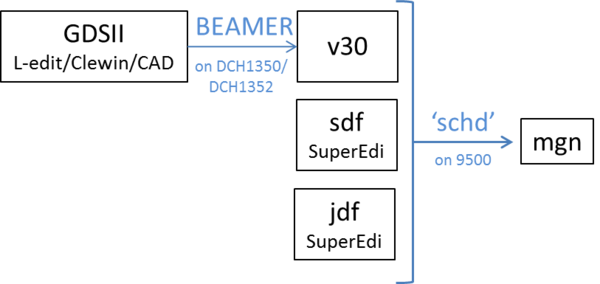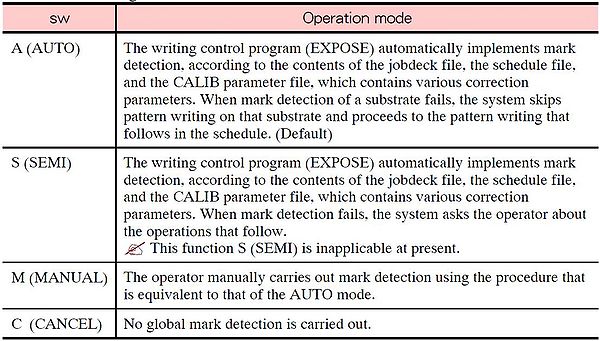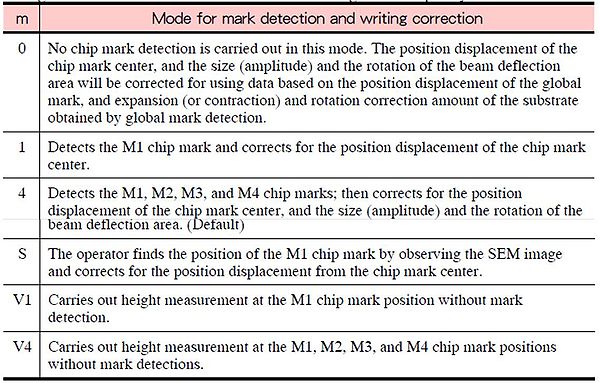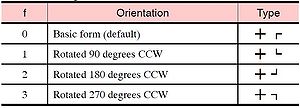Specific Process Knowledge/Lithography/EBeamLithography/FilePreparation
Feedback to this page: click here
File preparation for exposure on JEOL 9500
For pattern exposure on the JEOL 9500 tool the pattern must be stored in JEOLs own proprietary JEOL52v3.0 format, also known as V30. At DTU Nanolab we use Beamer to generate the V30 file from the original design file. We recommend using GDS as the original file format although Beamer can read multiple formats. In addition to the a pattern file exposure requires a Schedule file (SDF) and a Jobdeck file (JDF). These are text files where the user defines exposure conditions. Before pattern writing these three files (V30, SDF and JDF) are compiled into a final magazine file (MGN) which fully defines the exposure job.
Conversion from GDS to V30 in Beamer
Beamer has a lot of different modules and can be used to manipulate a design considerably. In this section we will only look at how to import a design file and export it to V30.
Beamer uses a node based workflow and each task is defined by a node with its own set of parameter. For this simple example we will only use the "Import" and "Export" nodes.
Basic SDF conten
Basic JDF content
If the layout is asymmetric, the conversion might result in an offset of the final layout onto the wafer. It is therefore recommended to symmetrise the layout, e.g. by inserting small structures in the corners of a rectangle that covers the layout.
How to convert to GDS in L-edit:
1 In L-edit, click File/Export Mask Data/GDSII
2 Choose Default GDSII unit: 1 database unit = 0.001 microns
Even though you do not export hidden layers or un-selected cells, unwanted layers might appear in the final GDSII file. Therefore, after conversion til GDSII, check your layout in a different layout viewer, e.g. CleWin (freeware), or BEAMER.
Converting from GDS to v30 (BEAMER)
The gds-file is converted to a v30-file by using the programme BEAMER. Please read the special BEAMER manual for a more advanced description of the BEAMER program.
- Open BEAMER.
- Drag the ‘Import’-module to the top-right window of Layout Beamer, open the gds-file to convert
- If the pattern has abutting polygons and even overlapping polygons which lead to double exposure, incorrect simulations etc., this can be fixed by running a ‘Heal’ program; drag the ‘HEAL’-module on top of the gds-file
- Drag the ‘Export’-module on top of the gds-file, export to the location ‘C:\1 gds files\name\date’. Export in JEOL52-format and change field-size to 1000µm x 1000 µm (under 'Advanced’). Click RUN on the Export-icon to execute the whole procedure
The gds-file is now converted to v30-format. In order to check the layout pattern double-click on the v30-module and and a VIEW LAYOUT window will open.
Preparing sdf and jdf files
Sdf- and jdf-files should not be created or edited in a regular notepad or wordpad program. Use only SuperEdi, which is freeware and available on the computers in the e-beam room. When you save a sdf- or jdf-file in SuperEdi, make sure to set the line endings to UNIX.
Both the sdf- and jdf-file should carry names using no capital letters.
You can find templates of sdf- and jdf-files in the folder home/eb0/jeoleb/job/templates on the 9500 computer.
Simple sdf and jdf files
sdf-file
The sdf-file contains a series of commands and parameters that specifies jdf filename, type
of cassette, shot pitch and condition file. It also specifies whether the pattern to be exposed requires alignment.
Below, an explanation of the template 'simple.sdf'. Note that semicolon outcomments the text:
___________________________________________________________________________
MAGAZIN 'SIMPLE1' The magazine name is SIMPLE1; max. 20 capital letters
#6 Cassette from slot no. 6 is used
%4A Wafer of 4" in position A is exposed
JDF 'simple',1 Layer block no. 1 of the jdf-file 'simple.jdf' is exposed
ACC 100 Acceleration voltage of 100keV is used
CALPRM '0.2na_ap5' The condition file 0.2na_ap5 is used
DEFMODE 2 Both deflectors are used (default)
RESIST 240 A dose of 240 µC/cm2 is used
SHOT A,16 The shot step between individual beam shots is 4 nm - steps of 0.25 nm
OFFSET(0,0) An offset of 0 µm is applied in both X and Y
END After exposure, the stage is left empty, i.e. the cassette is unloaded
___________________________________________________________________________
Note that the unit in the SHOT command is in 0.25nm, i.e. 'SHOT A,16' gives a shot pitch of 4nm. If the next user of the machine has loaded a cassette in slot #10 and you wish to load that cassette after exposure, you can finalize the sdf-file with 'END 10'.
jdf-file
The jdf-file contains a series of commands and parameters that specifies what pattern (v30-file) is to be written where on the sample. It also specifies what calibrations are to be performed during writing.
The jdf-file 'simple.jdf' could look like this:
___________________________________________________________________________
JOB/W 'SIMPLE',4 4" wafer, jobname is 'SIMPLE', max. 20 capital letters
PATH DRF5M The DRF5M calibration is used (see section 3.3)
ARRAY (0,3,2000)/(0,3,3000) see note 1
ASSIGN P(1) -> (*,1) Pattern 1 is assigned to row 1-3 coloumn 1
ASSIGN P(2) -> (*,2-3) Pattern 2 is assigned to row 1-3 coloumn 2-3
SKIP (1,1) Nothing is assigned to chip (1,1)
AEND End-command to 'ARRAY'
PEND End-command to 'PATH'
LAYER 1 Start of layer block 1
P(1) 'template1.v30' Pattern 1 defined in 'template1.v30'
P(2) 'template2.v30' Pattern 2 defined in 'template2.v30'
SPPRM 4.0,,,,1.0,1 Beam parameters (default - see section 6.2)
STDCUR 0.22 ;nA Beam current (in nA) used for writing, see note 2
END End of jdf-file
___________________________________________________________________________
Note 1: 9 chips are written, the upper left chip has center in (X,Y) = (0,0). The pitch between the chips is 2 mm in x-direction and 3 mm in y-direction.
Note 2: You should always add 10% to the current defined in 'STDCUR'; this ensures you work well below a scan speed of 100 MHz and thus gives room for a fluctuating current.
___________________________________________________________________________
Calibration during writing (PATH)
The inital and cyclic calibration before and during an e-beam run is defined in the jdf-file, e.g. by 'PATH DRF5M'.
Every time a jdf-file is called from a sdf-file, i.e. for every sequence defined in the sdf-file, the inital calibration specified in the jdf-file will be executed. Therefore, in order to save writing time, design your files so as to keep as few sequences in the sdf-file as possible.
There are a number of calibration programs to chose from, the DRF5M is recommended when no alignment is required and FT01 recommended if alignment is required:
auto calib file calibrations
NO ALIGNMENT
DRF5M INITIAL: HEIMAP, CURRNT, DRIFT
CYCLIC: CURRNT, DRIFT (every 5 minutes without interupting the writing of a field)
MASK01 INITIAL: HEIMAP, CURRENT, INITBE, PDEFBE, SUBDEFBE
CYCLIC: CURRNT, DRIFT (every 5 minutes without interupting the writing of a field)
ALIGNMENT
CUR5M INITIAL: CURRNT
CYCLIC: CURRNT (every 5 minutes without interupting the writing of a field)
DIRE01 INITIAL: PDEFBE, SUBDEFBE, CURRENT
CYCLIC: CURRNT (every 5 minutes without interupting the writing of a field)
The full list of calibration paths are available here.
Alignment and global mark detection
Alignment of an e-beamed pattern to an existing pattern on wafer or chip (direct writing mode) requires at least two alignment marks, P and Q, preferably positioned in quadrant II and IV of the wafer or chip (the x-coordinate of the global mark Q must be equal to or larger than the x-coordinate of the global mark P).
Before loading the cassette into the e-beam writer, the wafer or chip should be pre-aligned using the optical pre-aligner setup in the e-beam room. A description of this procedure is included in the main manual of the e-beam writer.
HEIMAP is discarded in direct writing mode, it thus is important to insert height measurements, by the HSWITCH and CHIPAL V1 or CHIPAL V4 command in the sdf-file. The height of the substrate will in either case be measured by a laser beam with a spot size 0.94 mm x 0.08 mm on the substrate.
HSWITCH:
HSWITCH ON,OFF: machine focusses beam to the Height average between P and Q marks
HSWITCH OFF,ON: machine focusses beam to the height average of chip marks
HSWITCH ON,ON: machine focusses beam to the height average of chip marks. The chip mark height will overrule the P and Q mark height during exposure.
If HSWITCH is omitted, HSWITCH ON, ON is default
CHIPAL V1/V4:
The virtual CHIPAL command in the sdf-file, CHIPAL V1 or CHIPAL V4, can be used to measure the height of the substrate at well-defined positions on the substrate, thus correcting for height variations before pattern writing. To use this, HSWITCH should be set to 'HSWITCH OFF,ON' or 'HSWITCH ON,ON'.
CHIPAL V1: machine measures height at chip mark M1 (machine does not scan the mark) and focusses beam to this height before exposing
CHIPAL V4: machine measures height at chip mark M1, M2, M3 and M4 (machine does not scan the marks) and focusses beam to the average height before exposing
_____________________________________________________________
MAGAZIN 'ALIGN'
#1 Cassette from slot no. 1 is used
%4A Wafer of 4" in position A is exposed
JDF 'align',1 Layer block no. 1 of the jdf-file 'align.jdf' is exposed
ACC 100 Acceleration voltage is 100keV
CALPRM '0.2na_ap5' The condition file 0.2na_ap5 is used
DEFMODE 2 Both deflectors are used (default)
GLMDET S Semi-automatic global mark detection is used
CHIPAL 0 No chip-mark detection is used
HSWITCH OFF,ON Height mesaurements at chip mark positions
RESIST 240 A dose of 240 µC/cm2 is used
SHOT A,16 The shot step between individual beam shots is 4 nm
OFFSET(0,0) An offset of 0 µm is applied in both X and Y
END 1 After exposure, cassette no. 1 is left on stage
______________________________________________________________
The parameters in the GLMDET-command can be as follows:
And the parameters in the CHIPAL-command can be as follows:
The global- and chip-mark position, size and orientation should be specified in the jdf-file:
______________________________________________________________
JOB/W 'ALIGN',4 4" wafer, jobname is 'SIMPLE'
GLMPOS P=(-7980,180),Q=(7960,-180) Position of P and Q mark
GLMP 4.0,1000.0,t,f see note 1
PATH FT01 use FT01 when aligning, sec. 3.3
ARRAY (0,1,1000)/(0,1,1000) 1 chip starting in (0,0) is written
CHMPOS M1=(-350,350),M2=(350,350), Chipmark pos. in chip coordinate sys.
M3=(350,-350),M4=(-350,-350)
CHMARK 4.0,15.0, t, f see note 1
ASSIGN P(1) -> (*,*) All chips are assigned to pattern 1
AEND End-command to 'ARRAY'
PEND End-command to 'PATH'
LAYER 1 Layer 1 in the v30 file is written
P(1) 'align.v30' Pattern 1 defined in 'align.v30'
SPPRM 4.0,,,,1.0,1 Beam parameters (see section 6.2)
STDCUR 0.22 ;nA Beam current (nA), se note 2.
END End of jdf-file
_______________________________________________________________
note 1: Width, length, type and orientation of global marks (GLMP) or chipmarks (CHMARK); the settings of the parameters t (type) and f (orientation) are listed in the two tables below:
note 2: Always add 10% to the current in this command to make sure you work well below 100 MHz and thus will not be affected if the current fluctuates above the base current.
Dose variation
The dose modulation is defined in a percentage addition to the base dose, i.e. the final dose, Q, is given by the base dose, RESIST, and modulation, m, by this formula:
Q = (RESIST · (100 + m))/100
In the jdf-file, you assign different layers of the pattern to different dose modulations, m.
If you define the dose variations by different datatype or layertype as described in section 3.2 of the BEAMER manual, you should define the dose for each layer number. You can check the layer numbers in BEAMER when you view the pattern, as seen in section 3.1 and 3.2 in the BEAMER manual.
JOB/W 'TINE1',4 ;4inch wafer PATH DRF5M ARRAY (-500,1,1000)/(500,1,1000) ASSIGN P(1)->((*,*),SHOT1) AEND PEND LAYER 1 P(1) 'tinegjul122013a.v30' SPPRM 4.0,,,,1.0,1 STDCUR 2.2 ;nA SHOT1: MODULAT (( 0, -10) , ( 1, 0) , ( 2, 10)) END
The above example subtracts 10% from the base dose in layer 0 and adds 10% to the base dose in layer 2.
Alternatively, you can make simple dose variations by repeating a simple structure in an array in the jdf-file, and dedicate different part of the array to different doses:
JOB/W 'TINE1',4 ;4inch wafer
PATH DRF5M
ARRAY (-1500,3,1000)/(1500,1,1000)
ASSIGN P(1)->((1,1),SHOT1)
ASSIGN P(1)->((2,1),SHOT2)
ASSIGN P(1)->((3,1),SHOT3)
AEND
PEND
LAYER 1
P(1) 'tinegjul122013b.v30'
SPPRM 4.0,,,,1.0,1
STDCUR 2.2 ;nA
SHOT1: MODULAT (( 0,-10))
SHOT2: MODULAT (( 0,0 ))
SHOT3: MODULAT (( 0,10))
END
Double current exposure
Before running a double-current exposure, you should receive training from a person from the e-beam staff. If this procedure is not performed correctly, it might end up in large pattern shifts.
A double-current exposure requires calibration of 2 condition files, of which you should calibrate the large current first and the small current afterwards. If the two patterns are aligned to each other, one should make sure the two condition files scan the same drift mark. The procedure is as follows:
- Load, restore and calibrate the condition file with the large current. When you scan the drift mark (using DRIFT), note the position of the drift mark (the position is written in the result display area of the calibration window).
- Increase the scan width in DRIFT to 40 µm in both X and Y. Save and execute DRIFT again.
- Save the condition file as usual.
- Load, restore and calibrate the condition file with the smallest current. When you scan the drift mark, make sure it scans the same mark as on the former condition file, i.e. that the two positions are equal within a few µm. If they are not, call a person from the e-beam team for help.
- Save the condition file as usual.
When you start the exposure, you call the condition file with the small current first. When the condition file with the large current is called, the state of the machine is restored to the condition file by the command 'RESTOR 1' in the sdf-file:
_____________________________________________________________
MAGAZIN 'DOUBLE'
#4
%4A
JDF 'smallcurrent',1
ACC 100
CALPRM '0.2na_ap5'
DEFMODE 2
RESIST 240
SHOT A,8
OFFSET(0,0)
#4
%4A
JDF 'largecurrent',1
ACC 100
CALPRM '10na_ap6'
DEFMODE 2
RESTOR 1 Coloumn is restored to 10na_ap6 and lenses are demagnetized
RESIST 240
SHOT A,18
OFFSET(0,0)
END 4
______________________________________________________________
Using the 'RESTOR' command without '1' the condition file will be restored without demagnetizing of the lenses.
Arrays of arrays
If you need to pattern a structure that consists of repetitions of a single pattern, you can easily design the pattern using arrays of arrays in the jdf-file.
This pattern has two arrays; array no. 1 consists of a column of 3 different chips, array no. 2 consists of 6 rows, each row containing array no. 1, thus endning up with 18 chips in a matrix of 6 x 3 chips. A shot modulation of -30% is applied to the first column of the matrix, a shot modulation of -20% is applied to column 2-6.
The upper left chip of the matrix is positioned in (X,Y) = (-7000,7000) micrometer.
JOB/W 'TEST',4
PATH DRF5M
ARRAY (-7000,1,0)/(7000,1,0)
ASSIGN A(2) ->(*,*)
AEND
2: ARRAY (0,6,1000)/(0,1,0)
ASSIGN A(1) -> ((1,1),SHOT1)
ASSIGN A(1) -> ((2-6,1),SHOT2)
AEND
1: ARRAY (0,1,0)/(0,3,1000)
ASSIGN P(1) -> (1,1)
ASSIGN P(2) -> (1,2)
ASSIGN P(3) -> (1,3)
AEND
P(1) 'resolution1.v30'
P(2) 'resolution2.v30'
P(3) 'resolution3.v30'
STDCUR 2
SPPRM 4.0,,,,1.0,1
SHOT1: MODULAT ((0,-30))
SHOT2: MODULAT ((0,-20))
END
MULTIPASS and OVERLAP
When defining the v30-file to be exposed, e.g.
P(3) 'resolution3.v30'
either a multipass or overlap function can be added, e.g.
P(3) 'resolution3.v30',OVERLAP,2
In this case, each field of pattern data is written twice with half the dose. This is suitable if you expose delicate structures on a resist that tends to overheat. The MULTI-function additionally shifts the field positions, in order to smear out stitching errors:
| command | ||
|---|---|---|
| MULTI, n | MULTI/FP | OVERLAP,n |
| Specifies execution of the field shift overlap writing mode. In this mode, overlap pattern writing is performed n times, applying one nth of the normal e-beam dose, by changing the writing position on the writing fields of pattern data. | Carries out the field shift overlap writing for the entire chip, in order from the first overlap, without mixing the writing fields of different overlaps. | Specifies execution of the overlap writing mode. In this mode, overlap pattern writing is performed n times, applying one nth of the normal e-beam dose on the writing fields of pattern data. |
Location of sdf and jdf files on the 9500 computer and compiling to mgn
Prepare jdf- and sdf-files according to the sections above.
Open FFFTP from the desktop of the preparation computer and connect to 9500. Move the jdf, adf and v30 files to the 9500 computer. The files should be located here before final compilation:
file type and its location (9500 computer)
sdf home/eb0/jeoleb/job/danchip jdf home/eb0/jeoleb/job/danchip v30 home/eb0/jeoleb/pattern/danchipv30
The sdf-file (with name 'sdfname.sdf'), the jdf-file (with name 'jdfname.jdf') and the v30-files are checked or compiled from a terminal from the location (DTU)/job/danchip with the following commands:
command
schd sdfname Final compilation of sdf, jdf and v30-files, creates a mgn-file schd -exptim sdfname Final compilation of sdf, jdf and v30-files, creates a mgn-files and states the writing time estimate wrtestui Opens a user interfaces wherefrom writing time etismation of a mgn-file can be estimated
After exposure, the sdf, jdf, and mgn-files are moved to this directory: home/eb0/jeoleb/job/danchipoldfiles.
A console may be opened by clicking Console in the Hosts tab (small triangle above 'cpu disk') in the tree at the bottom of the workspace. In the console, Ctrl + p or n may be used to browse through previous commands.
Checking the layout of the final mgn-file in ACHK
The final check of pattern is performed clicking ‘Achk’ in the Analysis window:
- Open the mgn-file to inspect. Click on the pattern once (the pattern area turns red) and click ‘View/Shot Shape Display...’ to look at the actual pattern.
- Mark ‘Colored shot rank’ and ‘Fill in a pattern’ and select ‘ASD’ under ‘Shot form’. In order to see individual shots, zoom in and select a structure.
- Click the ‘Simulation ...’ button to select the correct Objective aperture. The simulated beam diameter will be displayed in the simulation window
Check that the pattern has not shifted in coordinates: In case it has, the pattern can be shifted back by manually changing the array-parameters in the jdf-file, or the SHIFT coordinates in the sdf-file
When the pattern is accepted by user, the e-beam exposure can start.
Examples of sdf and jdf files
| 20 coloums of chips on a wafer; the first 10 coloums of the array is exposed with one shot pitch, the rest of the chips with another. | |
|---|---|
| An array of 20 chips is written on one 4" wafer. The first 10 coloums of the array is defined in layer block no. 1 of the jdf, coloumn 11-20 is defined in layer block no. 2 of the jdf. The two layer blocks uses different beam shot pitch and base dose. The two layer blocks must be called in two different sequences in the sdf-file. | |
|
SDF file MAGAZIN 'LAYERS' #1 %4A JDF 'layers',1 ACC 100 CALPRM '0.2na_ap5' DEFMODE 2 OFFSET(0,0) #1 %4A JDF 'layers',2 ACC 100 CALPRM '0.2na_ap5' DEFMODE 2 OFFSET(0,0) END 1 JDF FILE JOB/W 'TWOLAYERS',4
PATH DRF5M
ARRAY (-10000,20,2000)/( 10000,20,2000)
ASSIGN P(1) -> (1-10,*)
ASSIGN P(2) -> (11-20,*)
AEND
PEND
LAYER 1
P( 1 ) 'test2.v30'
SPPRM 4.0,,,,1.0,1
SHOT A,20
RESIST 220
STDCUR 0.22 ;nA
LAYER 2
P( 2 ) 'test2.v30'
SPPRM 4.0,,,,1.0,1
SHOT A,40
RESIST 250
STDCUR 0.22 ;nA
END
| |
| Dose-modulated pattern aligned to global marks and chip marks on a 4" wafer | |
|---|---|
| A 3*3 array of chips, each 1 mm*1 mm in size, is written on a 4” wafer. The pattern is aligned to global marks and every chip i aligned to chip marks. The top left chip of the array (of patterns) is centered at (X,Y) = (-35000,35000). All chips are written with pattern ‘mettekjan2012.v30’. A dose modulation of 48 levels is applied to each chip. Before exposure, the calibration-path ‘HEI’ is applied. | |
|
SDF file MAGAZIN 'LAYERS' #1 %4A JDF 'berit',1 ACC 100 CALPRM '0.2na_ap5' GLMDET S CHIPAL 4 DEFMODE 2 OFFSET(0,0) END 1 JDF FILE JOB/W 'BERIT',4 PATH HEI ARRAY (-35000,3,1000)/(35000,3,1000) CHMPOS M1=(-3500,3500),M2=(3500,3500),M3=(3500,-3500),M4=(-3500,-3500) CHMARK 4.0,15.0 ASSIGN P(1)->((*,*),SHOT1) AEND PEND LAYER 1 P(1) 'mettekjan2012.v30' SPPRM 4.0,,,,1.0,1 STDCUR 0.88 ;nA SHOT1: MODULAT (( 0, -2.8 ) , ( 1, -2.0 ) , ( 2, -1.2 ) - , ( 3, -0.4 ) , ( 4, 0.5 ) , ( 5, 1.3 ) - , ( 6, 2.1 ) , ( 7, 3.0 ) , ( 8, 3.9 ) - , ( 9, 4.7 ) , ( 10, 5.6 ) , ( 11, 6.5 ) - , ( 12, 7.3 ) , ( 13, 8.2 ) , ( 14, 9.1 ) - , ( 15, 10.0 ) , ( 16, 11.0 ) , ( 17, 11.9 ) - , ( 18, 12.8 ) , ( 19, 13.7 ) , ( 20, 14.7 ) - , ( 21, 15.6 ) , ( 22, 16.6 ) , ( 23, 17.6 ) - , ( 24, 18.6 ) , ( 25, 19.5 ) , ( 26, 20.5 ) - , ( 27, 21.5 ) , ( 28, 22.5 ) , ( 29, 23.6 ) - , ( 30, 24.6 ) , ( 31, 25.6 ) , ( 32, 26.7 ) - , ( 33, 27.7 ) , ( 34, 28.8 ) , ( 35, 29.8 ) - , ( 36, 30.9 ) , ( 37, 32.0 ) , ( 38, 33.1 ) - , ( 39, 34.2 ) , ( 40, 35.3 ) , ( 41, 36.5 ) - , ( 42, 37.6 ) , ( 43, 38.7 ) , ( 44, 39.9 ) - , ( 45, 41.0 ) , ( 46, 42.2 ) , ( 47, 43.4 )) END | |
Troubleshooting
If the sdf- and jdf-files do not compile correctly with the v30-files, the EWS/9500 will come out with an error message that might be a bit difficult to comprehend. If this happens, check that these things are ok:
- The names of the sdf- and jdf-files might be too long; the maximum number of characters is not specified anywhere in the JEOL manual, but keep the names shorter than 20 characters to be sure.
- The sdf-, jdf-, or v30-file might not exist or might be located in the wrong directory; see section 1.1 in this manual to see where they should be located.
- The compilation command 'schd' is performed from the wrong directory, see section 1.1 in this manual to see from where it should be called.
- The order of commands might be wrong in either the sdf- or jdf-file; check the order of commands in the templates in the directory home/eb0/jeoleb/job/templates
- The sdf- or jdf-files might have been opened in a text-program different from SuperEdi, e.g. notepad; this can corrupt the files and add linefeeds or tokens at line-ends. This can be checked in SuperEdi. In most cases, the problem can be solved by opening the sdf- and jdf-file in SuperEdi and save it again while setting the line endings to UNIX.
- If none of the above works find a template home/eb0/jeoleb/job/templates and re-write your information into it, do NOT copy for the reasons of the last point above.
- The path writing requires a scan speed larger than 100MHz; increase the shot pitch (SHOT) in the sdf-file and compile again.




